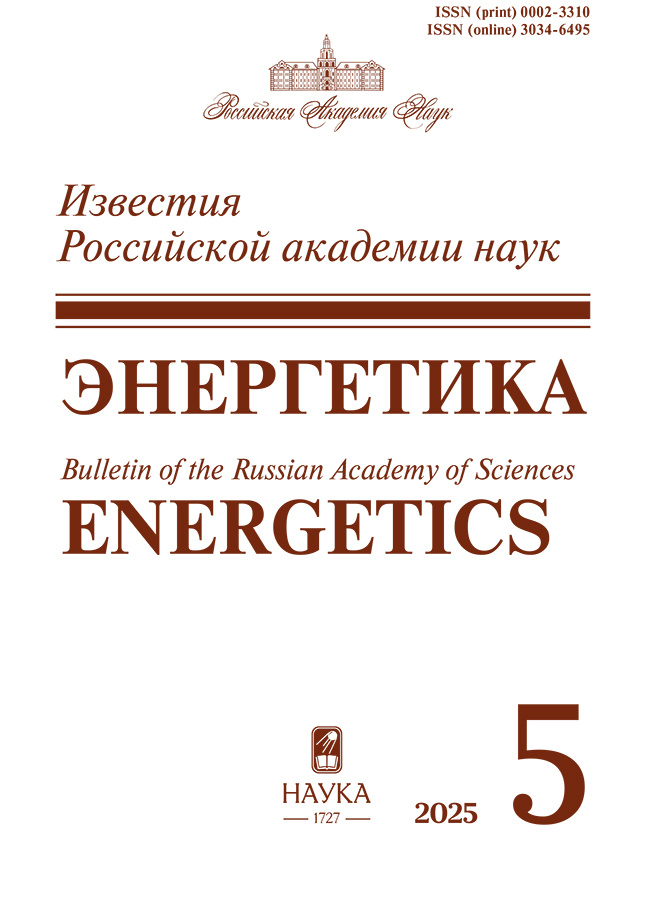Izvestiâ Akademii nauk SSSR. Ènergetika
ISSN (print): 0002-3310
Media registration certificate: ПИ № ФС 77 - 67158 от 16.09.2016
Founder: Russian Academy of Sciences
Editor-in-chief: Volkov E.P., academician RAS, Doctor of Sc., Full Professor
Frequency / Access: 6 issues per year / Subscription
Included in: White list (4th level), Higher Attestation Commission list, RISC
Ағымдағы шығарылым
№ 5 (2025)
Articles
Study of gas supply options for the southern regions of the Irkutsk region
Аннотация
The paper presents options for gas supply to the Irkutsk Region. One option proposes to use gas from the Kovyktinskoye field, while the other one proposes to use gas from the northern oil and gas condensate fields. To solve the tasks, the method of complex optimization of continuously and discretely changing parameters of heat and power systems developed at the Melentiev Energy Systems Institute of Siberian Branch of the Russian Academy of Sciences was used. Optimization was carried out according to the criterion of the minimum average price of gas at the outlet of the gas pipeline. Research has shown that gas from the proposed fields has a competitive price that will allow the successful development of the region’s economy.
 3-18
3-18


Methodological issues and prospective directions of using low-potential heat sources
Аннотация
The article considers methodological issues related to the assessment of the potential and further use of low-potential heat sources. A definition of these sources is given. Based on the thermodynamic approach, the temperature boundaries of the low-potential heatsources for various types of heat carriers are determined. A special feature of the approach is the connection between the upper boundary of the low-potential heat source and the average temperature level of heat consumers for obtaining electrical energy and thermal energy. Five main groups of low-potential heat utilization technologies are identified. These include recirculation of heat carrier flows, heat recovery and regeneration, the use of heat transformers, the generation of electrical energy before transferring heat to the consumer, as well as obtaining cold based on low-potential heat in absorption refrigeration units. The most promising areas of low-potential heat source use are considered, and the corresponding consumers are given. It is noted that they cover almost all sectors of the Russian economy — energy, industry, housing and communal services, agriculture. It is shown that the currently available technical solutions are focused on the entire temperature range of low-potential heat sources and are able to meet the needs of a wide range of heat consumers.
 19-46
19-46


Solar collector-air heater with heat accumulator
Аннотация
The use of heat accumulators charged by solar energy allows to significantly improve the operation of solar air heaters, which is explained by the ability of such systems to function effectively without a fuel backup even in the complete absence of direct solar radiation. The main disadvantage of existing designs of solar air heaters with heat accumulators is the incomplete use of the surface of the container with heat-accumulating material in the charge and discharge cycles. A new design solution for a solar collector-air heater is proposed, which ensures the use of the entire external surface of the tubular containers with heat-accumulating material in the process of heat exchange during the operation of the installation. The laboratory and full-scale tests of an experimental sample of such an installation have obtained data on the heat of fusion of the heat-accumulating composition and the productivity of heated air in different periods of the year. The implementation of such a plant in the climatic conditions of Makhachkala allows for the production of heated air in a volume of up to 734 m3/day from each square meter of absorber and up to 21 m3/day from 1 kg of the adopted heat-accumulating composition.
 47-60
47-60


A REVIEW OF CURRENT TRENDS AND CHALLENGES IN THE APPLICATION OF DIGITAL TWINS AND ARTIFICIAL INTELLIGENCE IN ENERGY SYSTEMS OF THE OIL AND GAS INDUSTRY
Аннотация
This paper presents a review of the current state and development directions of digital twin (DT) and artificial intelligence (AI) technologies, with a focus on their application in energy systems at oil and gas industry facilities. The architectural foundations of DTs are examined, including the six-level model and its classification by levels and application domains. Key AI methods used in conjunction with DTs are discussed, such as machine learning for load and renewable generation forecasting, reinforcement learning for control optimization under uncertainty, and generative AI for decision support and scenario modeling. Applied solutions are considered in detail, including predictive maintenance of equipment, optimization of associated petroleumgas utilization, and the development of intelligent energy management systems. Current challenges and issues are identified, including data processing infrastructure selection, cybersecurity, and economic and legal regulation. Prospects for DT implementation are outlined, taking into account international and Russian environmental requirements, in particular the target of utilizing at least 95% of associated petroleum gas by 2027. Examples of domestic and international developments and studies demonstrate that DT and AI technologies have significant potential for addressing tasks such as equipment monitoring, load forecasting, production process optimization, and automated energy system control in the oil and gas sector.
 61-85
61-85


Памяти академика РАН Волкова Эдуарда Петровича
 86-87
86-87











